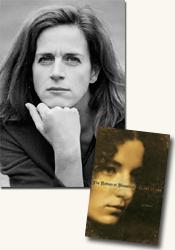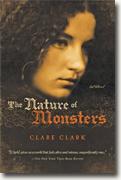author interview
book reviews:
· general fiction
· chick lit/romance
· sci-fi/fantasy
· graphic novels
· nonfiction
· audio books
· author interviews
· children's books @
curledupkids.com
· DVD reviews @
curledupdvd.com
newsletter
win books
buy online
links
home
for authors
& publishiss
for reviewers

|
|||||
 
Curledup.com contributor Luan Gaines interviewed Clare Clark,
author of the newly released The Nature of Monsters Interviewer Luan Gaines: What was your inspiration for The Nature of Monsters Clare Clark: The starting point for the novel was in fact a chance invitation from Sophie, a wall-painting conservator friend, to visit her latest project, the cleaning of the eight frescoed panels in the dome of St Paul’s Cathedral, painted by Sir James Thornhill, father-in-law to William Hogarth, between 1715 and 1719. Sophie’s working conditions were spectacular. She operated from a scaffolding suspended from the cathedral’s lantern. Between the planks that served as flooring, you could see the marble floor some 350 feet below. It felt perilously unsteady but, as Sophie pointed out, it was luxurious compared to the rickety platforms hoisted by a primitive system of ropes and pulleys upon which Thornhill and his team of artists had been obliged to work. Sophie also told me that the dome was not a single structure but three domes stacked one inside the other, thereby providing not only sufficient support for tons of lead but also the perfect proportions, inside and out. Later that afternoon, as I stood in the nave of the cathedral looking up, I knew then that my next book would have to be set in the shadows of that remarkable building. It did not end up being a book about the cathedral as I imagined then. Once I started researching the period, I found myself drawn towards the subject of science and superstition. But St Paul’s remains an important landmark in the novel, physically and thematically. Eighteenth-century England is filled with contradictions, old beliefs clashing with the new. Can you describe the strange confluence of science and superstition and the effect on society in general? The first decades of the eighteenth century found scientific understanding in a strange state of flux, halfway between the medieval period and the Enlightenment. Fifty years previously, William Harvey had discovered the circulation of the blood but the orthodoxy of humoral medicine – the ancient belief that the body was governed by four cardinal fluids or humours – persisted. There was an increasing stress laid by scientists upon dissection and the requirement for empirical proof but physicians continued to avoid the physical examination of ailing patients, considering such an approach a breach of social etiquette and sexual propriety. Instead they based their diagnoses upon their interpretations of a patient’s ‘history’. More importantly, the advance of rational scientific knowledge came up always against the resistance of deep-seated religious belief. The body was governed not only by mechanical principles but by the soul. At all levels of society, illness was still regarded by many as a matter of trial or punishment and death as divine retribution. Life was precarious and recovery a matter of God’s will.
What is the significance of the Great Fire of London in 1666 as related to the pregnant woman who barely escapes the conflagration? According to the convention of maternal impression, which traced its origins back to the Greek thinkers Hippocrates and Plato, the violent experiences or emotions of a pregnant woman would imprint themselves upon her unborn foetus. An unsatisfied longing for strawberries, then, would stain the child with a strawberry mark, while the case of the mother who had witnessed a man being broken upon the wheel and subsequently bore a child with broken limbs was well-documented. It would have seemed perfectly likely to an eighteenth-century person, therefore, that the terror experienced by a woman caught in the fire that consumed London in 1666 would have marked her unborn child indelibly. In 1718, Eliza Tally falls victim to lust, confusing her overwhelming emotions for love. Other than the problem of her pregnancy, what is the likelihood of a union with this wealthy young seducer? Does her uninhibited reaction to Campling betray Eliza’s class, an inability to identify behavior inappropriate to a proper lady? The likelihood of a union in this instance, when the couple had been ‘married’ and were expecting a child, would have been sufficient to make it worth the risk, though Eliza’s mother would have understood that the dangers were considerable. She would also have known, however, that, given their situation, Eliza’s options in life were very limited. As for Eliza’s response to Campling, I believe that this has less to do with her class than her character. She is headstrong, highly emotional and, at the outset of the novel, very self-centered. Hers was a life of rural poverty – for a girl of her passionate nature sexual adventure would have provided a very thrilling escape from the drudgery of day-to-day existence.
Certainly it was usual to bring servant girls into the city from the country at around this time as the increased prosperity that came about as a result of the boom in the newly established trade in company stocks meant that there was a shortage of servants in London and for a time those there were found themselves able to command unusually high wages. It was also common for a girl to be sent away when she fell pregnant to avoid a scandal. Though I do not know whether it became common practice to put the two together I don’t know but it seems reasonable to assume that it did happen from time to time. When first meeting the disfigured and dim-witted Mary, Eliza is barely able to contain her revulsion. How are such poor creatures as Mary viewed by society? Why is Eliza so hostile to the unfortunate maid? While Georgian society did not trouble itself with the political correctness of our age and commonly mocked and laughed at the afflicted, it was also much more accepting of imperfection than we in our Botox-obsessed times have become. There was no wastage in those times and this included human wastage so everyone who could worked, regardless of their disabilities. I think that Eliza’s hostility stemmed from a fear of what was going to happen to her. Trapped and afraid, it was the innocent but damaged Mary who was the easiest target for her frustration and dread. Personal contact with Mr. Black is forbidden to the servants without his permission; as well, Mrs. Black is a harsh taskmaster, Eliza’s life further tormented by Black’s apprentice, Edgar Pettigrew. How does her pregnancy affect Eliza’s response to her circumstances? Does she really believe that Mr. Black will assist in ridding her of the baby when her own mother refused? Eliza is obviously desperate to get rid of her unborn child, whom she regards as a kind of parasite. As long as the child is in her, she cannot put the unfortunate affair with the Campling boy behind her. Certainly she believes that Black will terminate the pregnancy, though she knows the process to be dangerous for them both, threatening her life and his liberty. She knows in her heart that there was nothing her mother could have done for her. In a small rural village, with spiteful gossip already starting to circulate about her, it would have been too easy for Ma Tally to be accused of the crime. In London, however, nobody knows Eliza or her circumstances and her pregnancy does not yet show. It would therefore be quite possible for the apothecary to administer something to end the pregnancy without raising suspicion. How does Black’s frightening physiognomy serve to intimidate the servants, namely Eliza and Mary? Does his drug use further exacerbate their fear? It is less his physiognomy that frightens Eliza than his disguise of it, which creates an alarming mystery around her master. Once she understands the true nature of his disfigurement she is fairly equable about it, though she thinks it unsightly. His drug use on the other hand makes him frighteningly unpredictable and exaggerates his instinctive view of them as scientific specimens without feelings or rights. As he becomes more addicted to opium his behaviour deteriorates. Even his wife is clearly afraid of him then. Given their proximity, Eliza eventually harbors an unwilling affection for the addled Mary. How does this need to connect with another overcome Eliza’s reluctance? Eliza’s first real connection with another comes, I think, with the birth of her child and when he dies she has a new rawness and humility that she has not known before. This opens her eyes to Mary’s sweet temperament and kind nature. When Mary is threatened as she herself was threatened, she becomes her passionate defender, driven not only by affection but by the chance to set things right, to protect her friend as she failed so terribly to protect her own child. The small window in Eliza’s sleeping quarters offers a view of St. Paul’s Cathedral. What is the impact of this landmark on Eliza when she first arrives in London? Does her perspective of the city and the dome change over time? When Eliza first stands on Hampstead Hill overlooking London she is astonished and overawed by the size and the grandeur of St Paul’s which seems to her to float above the enormous metropolis like a ship. For a girl who had only ever known a small country church it must have been breath-taking. When she first arrives in London and realizes she can see it from her window, she considers it her protector, a kind of talisman that will never let anything bad happen to her. It stands as a testament both to the power and majesty of God and to the ingenuity and relentless determination of humankind. Over time, as she herself suffers so profoundly at the hands of a similar kind of relentless ambition, this position changes and St Paul’s comes to serve as a reminder of her powerlessness and to reinforce the notion of an unjust and implacable God, who cares nothing for the suffering and exploitation of the people who live in its very shadow.
The bookseller shows Eliza that, although she might be a servant girl without money or influence and therefore vulnerable to the terrible fate to which Black seeks to consign her, she is not entirely defenseless. If she is prepared to use them properly, she has two powerful weapons, literacy and sexual power. Both of these offer her options not usually available to someone in her position. Transporting Black’s books back and forth to the bookseller, Eliza’s curiosity leads her to a shocking revelation. How does this revelation impact Eliza’s already considerable fears? Can you describe 18th-century society’s interest in “monsters”, especially as defined by the Royal Society and the interest in “monstrous births and extraordinary pregnancies”? The discovery of the book makes sense of things that Eliza has long known but never properly understood, that Black means to create a monster of the child that Mary is carrying and that he had attempted to do the same to her. ‘Monsters’, a term that broadly included any creature, child or animal, born in a form that did not conform to conventional expectation, be it conjoined twins, imperfectly formed limbs or other more minor conditions such as hare-lips or extensive birthmarks, fascinated scientists for there was no known explanation for them. A great deal of discussion went on about what caused these defects and why – in a world that sought to explain such phenomena both scientifically and religiously, this inspired a huge amount of interest and disagreement. The Nature of Monsters The challenge with this novel was to maintain the various strands of the story while keeping the very claustrophobic atmosphere of the house. I wanted the book to reflect Eliza’s feelings of increasing entrapment and panic and that meant that the plot was required to be very tight. I had to cut a number of scenes, especially ones that took place outside the house in Swan Street, as they contrived to cut that tension and reduce the impact of the novel’s denouement. Why does the Huguenot bookseller offer marriage to Eliza and on what terms? Is he not a classic hypocrite, providing Black’s books, yet judgmental with Eliza? The Huguenot’s offer of marriage is extremely self-interested. He proposes to her mainly as an act of revenge against his daughter, whose own proposed marriage he powerfully resents. Of course he knows too that if his daughter leaves him he will need someone to take care of him and the house and therefore Eliza is useful to him in that way also. That is not to say that he is not fond of her. He likes her spirit and her intellectual curiosity and he enjoys shaping her as he has obviously tried, and failed, to shape his daughter in her turn. I think it is fair to say that he is a hypocrite but I think his hypocrisy resides mainly in the fact that, for all his belief that he cares little for convention and is prepared to marry Eliza despite her status, he turns out to be profoundly conformist. He believes himself to be a far better man than Black but in the end he does nothing to protect Mary against him and is willing to see her on the street rather than risk his reputation. Adrift in an unfamiliar city, could Eliza realistically protect Mary or would both be victims of their sad circumstances? It seems unlikely that Eliza would have been able to protect Mary for long. By the time the child was born they were in desperate straits with little money and an illegitimate child to look after. Had it not been for Mary’s father it is hard to see how they would have contrived to support themselves. It was depressingly common for women in that situation to resort to begging or to prostitution. There was seldom any way back. Poverty, hunger and disease would have been likely to claim them before long. The most profound change for Eliza isn’t the escape from the Black household, but her growing affection, even love, for Mary. How does this relationship alter Eliza’s perspective and view of the future? I think Eliza does grow to love Mary and it is this love that redeems her, releasing her from her own preoccupations and forcing her to put someone else first. It is this transformation in her that drives the outcome of the novel. What did you find most challenging in writing The Nature of Monsters There are a great deal of challenges in writing any novel – the plot, the characters, the structure, you name it! But the challenge with a historical novel of this kind lies, I think, in transforming the historical information that one gleans from textbooks into a story that comes alive in its own right. And that of course is the reward of it too, realizing that you have created this world, that you have given a glimpse of another time and what it might have felt like to live as a woman in circumstances that we today would consider unbearable. Are you currently working on another novel? If so, can you share something about it with us? I have already begun my next book so I can tell you that I am – finally – leaving London behind. Having written two London books I wanted to explore a new place and have looked to the colonial period for inspiration. Put it this way, the next one is set to be a lot closer to home for a lot of my American readers! More than that I am reluctant to say at this point. Like many novelists I am rather superstitious about unfinished work. Clare Clark was born in London in 1967. A senior scholar at Trinity College Cambridge, she graduated with a double first in history. Her first novel, The Great Stink, was a New York Times Editors’ Choice, a Washington Post Best Book of the Year, long-listed for the Orange Prize, and the winner of the Quality Paperback Book Club New Voices Award. She is married with two children and lives in London. Contributing reviewer Luan Gaines interviewed Clare Clark, author of The Nature of Monsters (see accompanying review), about her book for curledup.com. Luan Gaines/2007.
|
|||||
| fiction · sf/f · comic books · nonfiction · audio newsletter · free book contest · buy books online review index · links · · authors & publishiss reviewers |
|
| site by ELBO Computing Resources, Inc. | |


